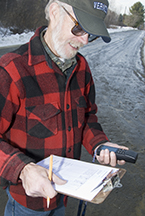Purpose
The purpose of the following information is to provide a uniform guide for measuring the coordinates of road intersections and recording it in your field notes. We will use this data as the starting point for each road description, based on the original survey data in the town records.
GPS Receiver
In order to have everyone's data in a consistant format for use later with the Geographic Information System (GIS) software, please set your GPS receiver to the following:
- set the map datum to NAD83
- set the units to english — feet or statute miles
- set the coordinate (latitude and longitude) display to decimal degrees ie. DDD.ddd We need at least 3 significant digits of precision, that is to say at least 3 digits to the right of the decimal point.
- if your receiver has a form of differential correction, such as Wide Area Augmentation System (WAAS), turn it on. It will improve the accuracy of your measurements.
While detailed instruction on the use of your GPS receiver is beyond the scope of this tutorial, user manuals for some models are available via down-load from the manufacturer's Web site. Several of the common manufacturers are: Garmin, Magellan, and Trimble.
Recording the Information
In your field notes, please record the following information for each intersection. If you are making hand written notes, please print.
- your name
- date that you took the measurement
- name of one road that forms the intersection
- name of the other road that forms the intersection
- latitude (DD.DDD) [In Hartland, these will be approximately 43°.]
- longitude (DDD.DDD) [In Hartland, these will be approximately 72°.]
- estimated position error (EPE)
- any useful comments
Making a Measurement
Once you get the receiver set as above, you are ready to go out and record the coordinates of a road intersection. Here are some recommended steps to follow.

|
|
Great! So now you have measured and recorded the location of a road intersection. You're well on the way to doing more intersections. Remember, keep good field notes — it's easy to get home later and find that you can't figure them out. And watch out for traffic!
Resources for your field work
Here are resources that you may find useful for doing the field work. They include maps, a form for recording your field data, and a list of road names.
- Map of Hartland
- This is a map of Hartland, based on the Vermont Agency of Transportation map, circa 2006. All of the road intersections have been numbered, and these intersection numbers can be recorded in your field notes. All road intersections within map inset areas are labeled in the respective inset. Complete map in PDF format (700KB)
- Blank form for field notes
- PDF form that you can print out and use to record your field notes.
- List of Hartland road names
- This is a list of Town, State, and Federal roads cross-referenced to the Town Highway (TH) numbers. NOTE: This is a preliminary list of road names. A few roads shown on the AoT map are not on the list of road names. The discrepancy is being looked into, and corrections will be posted as soon as possible.
- List of Hartland road intersections, town lines, and other points of interest
- This is a list of road intersections, town lines, private roads, and other points of interest, as noted on the maps above, cross-referenced with the names of the intersecting roads. NOTE: This is based on a preliminary list of road names. A few roads shown on the AoT map are not on the list of road names. The discrepancy is being looked into, and corrections will be posted as soon as possible.